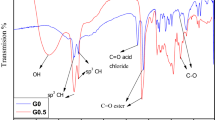Abstract
The bioinert interfaces that prevent adhesion of proteins and cells are important for biomaterial applications. In order to design a bioinert interface, the immobilization of an appropriate functional group and the control of molecular density is required. Dendrimer was modified with triethylene glycol (TEG) to display a dense brush structure. TEG with different density and terminal groups were immobilized with a dendrimer template and thiol terminated molecules. The inhibitory effect on protein and bacteria binding was investigated. The physical property of the interface was measured by QCM-admittance to clarify the factor of the bioinert property.
Similar content being viewed by others
References
K. L. Prime and G. M. Whitesides, Science, 1991, 252, 1164.
M. Mrksich, G. M. Sigal, and G. M. Whitesides, Langmuir, 1995, 11, 4383.
D. J. Kim, J. M. Lee, and B. G. Chung, Biotechnol. Bioeng., 2011, 108, 1194.
D. W. Branch, B. C. Wheeler, G. J. Brewer, and D. E. Leckband, Biomaterials, 2001, 22, 1035.
R. Gref, M. Lück, P. Quellec, M. Marchand, E. Dellacherie, S. Harnisch, T. Blunk, and R. H. Müller, Colloids Surf., B, 2000, 18, 301.
J. Ladd, Z. Zhang, S. Chen, J. C. Hower, and S. Jiang, Biomacromolecules, 2008, 9, 1357.
K. Ishihara, H. Nomura, T. Mihara, K. Kurita, Y. Iwasaki, and N. Nakabayashi, J. Biomed. Mater. Res., 1998, 39, 323.
R. A. Frazier, G. Matthijs, M. C. Davies, C. J. Roberts, E. Schacht, and S. J. B. Tendler, Biomaterials, 2000, 21, 957.
T. Hatakeyama, M. Tanaka, and H. Hatakeyama, Acta Biomater., 2010, 6, 2077.
J. C. Love, L. A. Estroff, J. K. Kriebel, R. G. Nuzzo, and G. M. Whitesides, Chem. Rev., 2005, 105, 1103.
M. Krishnamoorthy, S. Hakobyan, M. Ramstedt, and J. Gautrot, Chem. Rev., 2014, 114, 10976.
M. J. Fréchet and D. A. Tomalia (ed.), “Dendrimers and Other Dendritic Polymers”, 2001, Wiley, New York.
E. Matsumoto, T. Fukuda, and Y. Miura, Colloids Surf., B, 2011, 84, 280.
S. K. Oh, Y. G. Kim, H. Ye, and R. M. Crooks, Langmuir, 2003, 19, 10420.
T. Fukuda, E. Matsumoto, S. Onogi, and Y. Miura, Bioconjugate Chem., 2010, 21, 1079.
T. Satomi, Y. Nagasaki, H. Kobayashi, H. Otsuka, and K. Kataoka, Langmuir, 2007, 23, 6698.
H. Furusawa, T. Sekine, and T. Ozeki, Macromolecules, 2016, 49, 3463.
E. Ostuni, R. G. Chapman, M. N. Liang, G. Meluleni, G. Pier, D. E. Ingber, and G. M. Whitesides, Langmuir, 2001, 17, 6336.
G. Sauerbrey, Z. Phyzik, 1959, 155, 206.
H. Sota, H. Yoshimine, R. F. Whittier, M. Gotoh, Y. Shinohara, Y. Hasegawa, and Y. Okahata, Anal. Chem.. 2002, 74, 3592.
K. Sadman, C. G. Wiener, R. A. Weiss, C. C. White, K. R. Shull, and B. D. Vogt, Anal. Chem., 2018, 90, 4079.
M. V. Voinova, M. Jonson, and B. Kasemo, Biosens. Bioelectron., 2002, 17, 835.
J. R. Stokes, L. Macakova, A. Chojnicka-Paszun, C. G.. de Kruif, and H. H.. de Jongh, Langmuir, 2011, 27, 3474.
T. Ozeki, M. Morita, H. Yoshimine, H. Furusawa, and Y. Okahata, Anal. Chem., 2007, 79, 79.
P. C. Lau, J. R. Dutcher, T. J. Beveridge, and J. S. Lam, Biophys. J., 2009, 96, 2935.
V. Vogel and M. Sheetz, Nat. Rev. Mol. Cell Biol., 2006, 7, 265.
Acknowledgments
This study was supported by the Grant-in-Aid for Scientific Research B (JP19H02766), Grant-in-Aid for Challenging Research (Pioneering) (JP19K22971), and Grant-in-Aid for Scientific Research on Innovative Areas (JP20106003, JP20H05230 and JP20H04825), and Eno scientific foundation. We would like to express our appreciation for the fruitful discussion with Prof. Takeshi Hasegawa (Kyoto University).
Author information
Authors and Affiliations
Corresponding author
Electronic supplementary material
Rights and permissions
About this article
Cite this article
Miura, Y., Kojima, Y., Seto, H. et al. Bio-inert Properties of TEG Modified Dendrimer Interface. ANAL. SCI. 37, 519–523 (2021). https://doi.org/10.2116/analsci.20P388
Received:
Accepted:
Published:
Issue Date:
DOI: https://doi.org/10.2116/analsci.20P388




